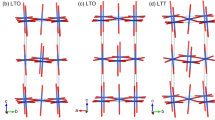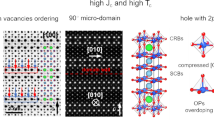Abstract
The crystal structure of a solid controls the interactions between the electronically active units and thus its electronic properties. In the high-temperature superconducting copper oxides, only one spatial arrangement of the electronically active Cu2+ units—a two-dimensional square lattice—is available to study the competition between the cooperative electronic states of magnetic order and superconductivity1. Crystals of the spherical molecular C603- anion support both superconductivity and magnetism but can consist of fundamentally distinct three-dimensional arrangements of the anions. Superconductivity in the A3C60 (A = alkali metal) fullerides has been exclusively associated with face-centred cubic (f.c.c.) packing of C603- (refs 2, 3), but recently the most expanded (and thus having the highest superconducting transition temperature, Tc; ref. 4) composition Cs3C60 has been isolated as a body-centred cubic (b.c.c.) packing, which supports both superconductivity and magnetic order5,6. Here we isolate the f.c.c. polymorph of Cs3C60 to show how the spatial arrangement of the electronically active units controls the competing superconducting and magnetic electronic ground states. Unlike all the other f.c.c. A3C60 fullerides, f.c.c. Cs3C60 is not a superconductor but a magnetic insulator at ambient pressure, and becomes superconducting under pressure. The magnetic ordering occurs at an order of magnitude lower temperature in the geometrically frustrated f.c.c. polymorph (Néel temperature TN = 2.2 K) than in the b.c.c.-based packing (TN = 46 K). The different lattice packings of C603- change Tc from 38 K in b.c.c. Cs3C60 to 35 K in f.c.c. Cs3C60 (the highest found in the f.c.c. A3C60 family). The existence of two superconducting packings of the same electronically active unit reveals that Tc scales universally in a structure-independent dome-like relationship with proximity to the Mott metal–insulator transition, which is governed by the role of electron correlations characteristic of high-temperature superconducting materials other than fullerides.
This is a preview of subscription content, access via your institution
Access options
Subscribe to this journal
Receive 51 print issues and online access
$199.00 per year
only $3.90 per issue
Buy this article
- Purchase on Springer Link
- Instant access to full article PDF
Prices may be subject to local taxes which are calculated during checkout




Similar content being viewed by others
References
Lee, P. A., Nagaosa, N. & Wen, X. G. Doping a Mott insulator: physics of high-temperature superconductivity. Rev. Mod. Phys. 78, 17–85 (2006)
Hebard, A. F. et al. Superconductivity at 18 K in potassium-doped C60 . Nature 350, 600–601 (1991)
Tanigaki, K. et al. Superconductivity at 33 K in CsxRbyC60 . Nature 352, 222–223 (1991)
Palstra, T. T. M. et al. Superconductivity at 40 K in cesium doped C60 . Solid State Commun. 93, 327–330 (1995)
Ganin, A. Y. et al. Bulk superconductivity at 38 K in a molecular system. Nature Mater. 7, 367–371 (2008)
Takabayashi, Y. et al. The disorder-free non-BCS superconductor Cs3C60 emerges from an antiferromagnetic insulator parent state. Science 323, 1585–1590 (2009)
Jeglič, P. et al. Low-moment antiferromagnetic ordering in triply charged cubic fullerides close to the metal-insulator transition. Phys. Rev. B 80, 195424 (2009)
Pennington, C. H. & Stenger, V. A. Nuclear magnetic resonance of C60 and fulleride superconductors. Rev. Mod. Phys. 68, 855–910 (1996)
Sato, N. et al. Analysis of 13C-NMR spectra in C60 superconductors: hyperfine coupling constants, electronic correlation effect, and magnetic penetration depth. Phys. Rev. B 58, 12433–12440 (1998)
Prassides, K. et al. Magnetic ordering in the ammoniated fulleride (ND3)K3C60 . J. Am. Chem. Soc. 121, 11227–11228 (1999)
Tanigaki, K. & Zhou, O. Conductivity and superconductivity in C60 fullerides. J. Phys. I 6, 2159–2173 (1996)
Darling, G. R., Ganin, A. Y., Rosseinsky, M. J., Takabayashi, Y. & Prassides, K. Intermolecular overlap geometry gives two classes of fulleride superconductor: electronic structure of 38 K Tc Cs3C60 . Phys. Rev. Lett. 101, 136404 (2008)
Gunnarsson, O., Han, J. E., Koch, E. & Crespi, V. H. Superconductivity in alkali-doped fullerides. Struct. Bond. 114, 71–101 (2005)
Gunnarsson, O., Koch, E. & Martin, R. M. Mott transition in degenerate Hubbard models: application to doped fullerenes. Phys. Rev. B 54, R11026–R11029 (1996)
Gunnarsson, O. Superconductivity in fullerides. Rev. Mod. Phys. 69, 575–606 (1997)
Capone, M., Fabrizio, M., Castellani, C. & Tosatti, E. Strongly correlated superconductivity. Science 296, 2364–2366 (2002)
Capone, M., Fabrizio, M., Castellani, C. & Tosatti, E. Modelling the unconventional superconducting properties of expanded A3C60 fullerides. Rev. Mod. Phys. 81, 943–958 (2009)
Wiebe, C. R. et al. Frustration-driven spin freezing in the S = 1/2 fcc perovskite Sr2MgReO6 . Phys. Rev. B 68, 134410 (2003)
Ihara, Y. et al. NMR study of the Mott transitions to superconductivity in the two Cs3C60 phases. Preprint at 〈http://arxiv.org/abs/1003.2937〉 (2010)
Bendele, G. M., Stephens, P. W. & Fischer, J. E. Octahedral cations in Rb3C60: reconciliation of conflicting evidence from different probes. Europhys. Lett. 41, 553–558 (1998)
Walstedt, R. E., Murphy, D. W. & Rosseinsky, M. J. Structural distortion in rubidium fulleride (Rb3C60) revealed by 87Rb NMR. Nature 362, 611–613 (1993)
Acknowledgements
We thank EPSRC for support (EP/G037132 and EP/G037949) and STFC for access to the synchrotron X-ray facilities at the ESRF (where we thank A. N. Fitch for assistance on beamline ID31) and Diamond (where we thank C. Tang for assistance on beamline I11) and to the muon facilities at ISIS. We also thank SPring-8 for access to the synchrotron X-ray facilities.
Author information
Authors and Affiliations
Contributions
M.J.R. and K.P. directed and coordinated the project. A.Y.G., M.T.M., M.D.T. and A.M. synthesized the samples. Y.T., A.Y.G. and K.P. performed the ambient pressure synchrotron XRD measurements and Y.T. analysed the data. Y.T., M.T.M. and M.D.T. carried out the ambient and high pressure magnetization measurements. Y.T., A.Y.G., Y.O., M.T. and K.P. performed the high pressure synchrotron XRD measurements and Y.T. analysed the data. Y.T., A.Y.G., P.J.B. and K.P. carried out the μSR measurements and K.P. and P.J.B. analysed the data. P.J., A.P. and D.A. performed and analysed the NMR measurements. G.R.D. carried out electronic structure calculations. M.J.R. and K.P. wrote the paper. All authors commented on the paper.
Corresponding authors
Ethics declarations
Competing interests
The authors declare no competing financial interests.
Supplementary information
Supplementary Information
This file contains a Supplementary Scheme S1, Supplementary Tables S1-S2, References and Supplementary Figures S1-S12 with legends. (PDF 2338 kb)
Rights and permissions
About this article
Cite this article
Ganin, A., Takabayashi, Y., Jeglič, P. et al. Polymorphism control of superconductivity and magnetism in Cs3C60 close to the Mott transition. Nature 466, 221–225 (2010). https://doi.org/10.1038/nature09120
Received:
Accepted:
Published:
Issue Date:
DOI: https://doi.org/10.1038/nature09120
This article is cited by
-
Stronger pairs with resonant excitation
Nature Physics (2023)
-
Flattened 1D fragments of fullerene C60 that exhibit robustness toward multi-electron reduction
Nature Communications (2023)
-
Tuning the electronic states and superconductivity in alkali fulleride films
AAPPS Bulletin (2022)
-
Merohedral disorder and impurity impacts on superconductivity of fullerenes
Communications Physics (2021)
-
Evidence for metastable photo-induced superconductivity in K3C60
Nature Physics (2021)
Comments
By submitting a comment you agree to abide by our Terms and Community Guidelines. If you find something abusive or that does not comply with our terms or guidelines please flag it as inappropriate.



